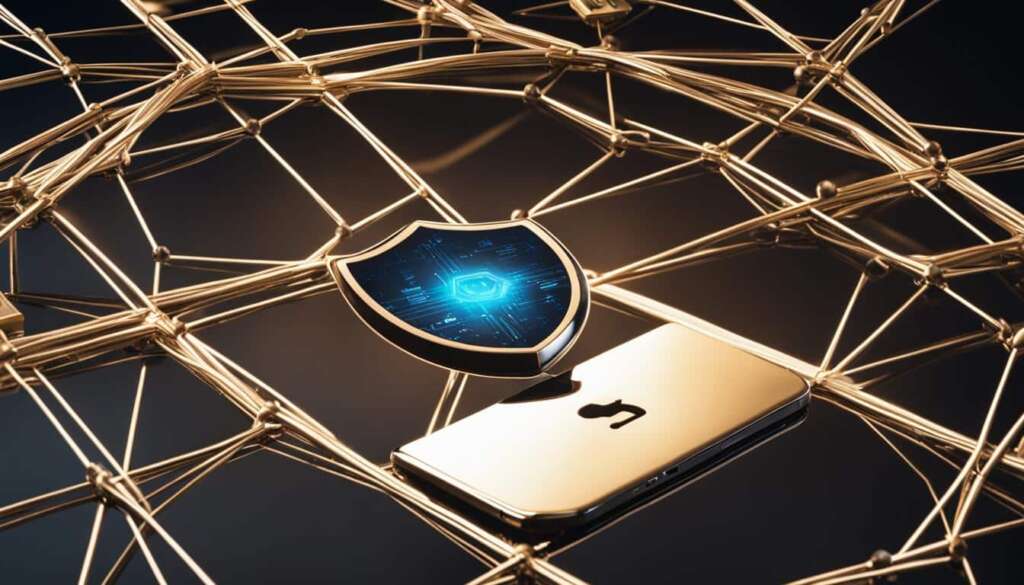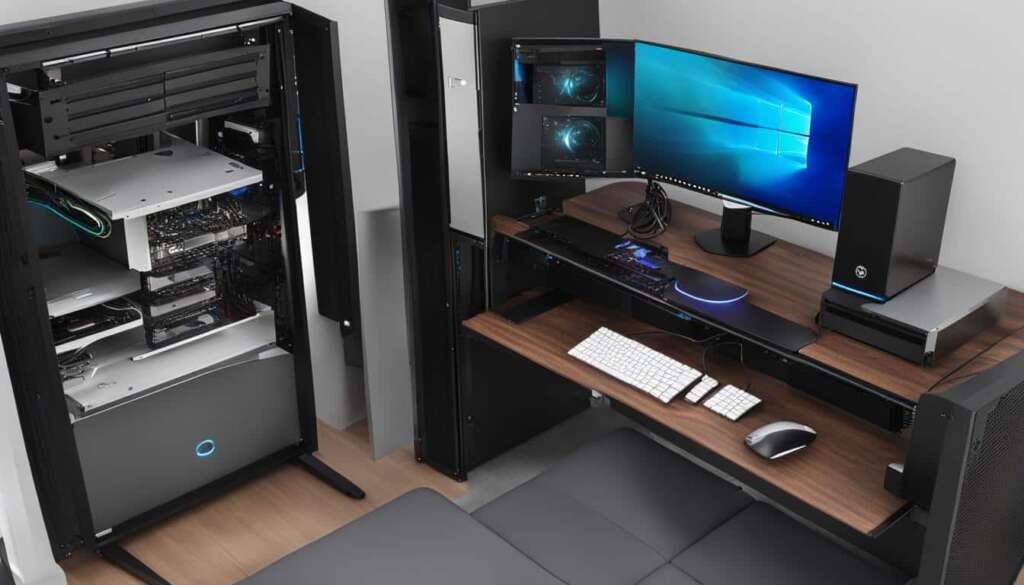Table of Contents
Many people wonder if it’s good to turn off their PC’s power supply. There is some confusion about what’s best. In this discussion, we will look at the benefits and risks of switching off your PC’s power supply.
Key Takeaways:
- Daily tasks like remotely turning lights on and off, running reports, starting the coffeemaker, and dispensing pet food can be easily scheduled to optimize power management and convenience.
- Creating a power management schedule can help protect devices from power events, extend the lifespan of your UPS system and electronics, and reduce overall ownership costs1.
- Power spikes and surges are common and can damage devices and data if left powered continuously. Turning off the power supply when not in use can prevent such issues.
- Scheduled reboots on computers can close unnecessary programs, avoid crashes and data corruption, save memory usage, and reset internet connections, ultimately extending the life of your device1.
- Keeping electronics powered on day and night increases energy costs and may lead to the need for repairs or replacements. Turning off the power supply when not in use preserves device health and longevity, resulting in significant cost savings1.
- The shutdown feature on a UPS system not only saves energy but also turns off peripherals connected to it, optimizing power consumption1.
- Registering your UPS with the manufacturer certifies the warranty, confirms ownership, and grants access to free technical support, ensuring smooth power management1.
- Regularly scheduled shutdowns and reboots are essential for keeping UPS systems and connected devices running smoothly1.
- Windows 7 and Windows Server 2008 R2 offer improved power settings for network adapters, reducing spurious wakes2.
- Controlling the “Allow the computer to turn off this device to save power” setting in Windows 7/Windows Server 2008 R2 determines how the network card is handled during sleep2.
Click here to find out what happens when a PC suddenly shuts down. It’s key to understanding how your power supply responds and how this affects your PC’s safety and lifespan.
In the next parts of our guide on Power Management, we’ll explore the importance of managing power well. Plus, we will share some helpful power management tips and tricks.
#powermanagement #turnoffpowersupply #PClongevity #PCsafety
The Importance of Power Management
Effective power management is key for keeping your PC running smoothly and safely. By using the right power management techniques, you can save energy and lower your electricity bills. It also keeps your PC safe from issues like power spikes and surges. Plus, power management betters your computer’s performance and makes your UPS system last longer.
One main goal of power management is to save energy. Back in 1996, technology was created to cut down on how much energy PCs and monitors use when they’re not being used3. The EPA found out that most new PCs and nearly all monitors sold then could manage power3. But, lots of computers don’t save energy because their power management isn’t switched on, it’s been turned off, or other computer parts interfere3. That’s why it’s crucial to turn on power management settings to save energy3.
Protecting your devices is another big part of power management. It doesn’t only cut down on energy use, it also reduces waste heat, which is good for the environment3. Power supplies are important for keeping your devices safe. They have charts that show how their efficiency changes depending on the load and voltage4. They also protect against too much current, too much heat, and voltage spikes4. All these features help your devices work better and last longer, keeping them safe from damage4.
Furthermore, power management boosts the overall working and dependability of your system. It works with every part of your computer, like the software, CPU, and peripherals. This can sometimes cause unexpected issues with how well power management works3. Managing power well means your PC will run better because it prevents issues from too much or too little power. It also makes sure your UPS system can keep your computer running during a power cut3.
In summary, power management is very important for saving energy, keeping devices safe, and making sure everything runs reliably. By following good power management practices, you can use less energy, pay less for electricity, and prevent damage to your PC. Also, proper power management boosts your computer’s performance and makes your devices last longer. This gives you a better and more reliable computing experience.
Benefits of Turning Off the Power Supply
Setting up a power management plan for your PC has many pluses. First, it protects your devices and data from unexpected power issues5. Having your computer on constantly can hike up your electric bill due to more power use. Turning your computer off and on many times might shorten its life because of the power surges at each start.
Second, this practice keeps you informed about your UPS system’s needs for regular check-ups5. Mechanical hard disks, which wear out from constant use, contrast with more lasting solid-state drives. It’s crucial to turn off your LCD screens when not in use, as they only last about 15,000 hours, or roughly two years.
Thirdly, regular restarts can boost your PC’s performance and help it last longer. Placing your computer in sleep mode saves more power and is less harmful than hibernate mode, which is similar to turning it on and off5. A surge protector or an uninterruptible power supply (UPS) can guard against power spikes, underscoring the value of power management tools.
Finally, power schedules are great for saving energy and cutting down costs by turning off unused electronics5. Keep your computer clean and its hard drive decluttered for better performance and longer life. Fortunately, modern PCs handle unexpected shutdowns better, reducing the risk of harm or data loss5.
By managing your power, you’ll boost device safety, save money, conserve energy, and extend your PC’s life.
How to Create a Power Management Schedule
Creating a power management schedule is key for better energy use and making your computer run smoothly. You can use software like PowerPanel® from CyberPower to set up when your PC should turn off or restart. This lets you manage your power in a smart way. You can set these times for different days of the week.
Having a good power management plan saves energy, which cuts costs and helps the planet. Many computers are left on all the time. Switching them off regularly can reduce your energy bills by 10-20%. So, you’re not only saving money but also contributing to a healthier environment.
This schedule also makes your devices last longer and prevents wear and tear. Regular restarting allows for important updates. Some tasks, around 60-70% according to data, can be set to shut down the computer once done. This saves time and resources.
Configuring Power Settings
It’s important to adjust your power settings to manage energy well. Some users might need help to stop others from changing these settings. Addressing such issues is key for a strong power management plan.
There could be questions on how power management affects system updates, or about policy application to users vs PCs. Clear advice is vital here. It’s important to know how to deal with settings that might override your policies.
Exception Handling and Practical Implementations
Setting exceptions for certain users is part of managing power schedules. You might face issues like Lenovo Thinkpad laptops not following settings. Offering solutions for these cases is essential for a solid power strategy.
Using group policy, you can apply your power management plans across a network. This method makes sure everyone follows the same rules. It’s a smart way to handle power settings for all users.
Scheduling Shutdowns and Reboots
For scheduling shutdowns and reboots, you can use the Task Scheduler in Windows. It lets you decide when your PC should turn off. According to data from link6, this tool makes it easy to include in your power plan.
MacOS users will find that older versions offer simple menus for scheduling. For newer versions, like macOS Ventura, you’ll need to use Terminal commands. Knowing the differences helps with seamless power management for Mac users.
A good power plan, supported by effective software and smart scheduling, increases energy efficiency, cuts down costs, and enhances your system’s performance. By addressing users’ needs and following best practices, you can achieve an optimal power routine. This will help you manage your computer’s energy use better.
Tips and Tricks for Power Management
Boost your power management with these easy tips. Learn how to make the most of your power, get your UPS system warranty sorted, and use power tools for top results.
1. Register Your UPS System
Got a new UPS system? Register it with the maker straight away. This move guarantees your warranty and offers you free tech support. It’s a smart way to ensure your power protection has full backing7.
2. Monitor Power Protection
Want to keep an eye on your power system’s performance? CyberPower’s power monitoring tools can help. They track power use, battery life, and more as it happens. This info lets you fine-tune your UPS system’s efficiency7.
3. Battery Replacement Options
As the UPS system gets older, the batteries will need changing. Know your options for battery replacement and pick quality ones that fit your UPS. This ensures your backup power is ready when you are. Check the UPS System Selector to make the right choice7.
4. Optimize Hard Disk Power Management
Changing your hard disk’s power settings is an easy win. Set a good time for it to turn off after not being used. This saves power and makes your battery last longer8.
5. Tweak Your Web Browsing Experience
Using Internet Explorer? Adjust the JavaScript for better speed and battery life. This can mean a smoother browsing with less power used8.
6. Manage Desktop Background Slideshow
Running a background slideshow? Turn it off when on battery to save power. Or switch it off completely to boost your system’s performance8.
7. Optimize Wireless Adapter Power Management
Wireles adapters have settings to balance network speed and battery life. Try different settings like Maximum Performance or Maximum Power Saving. Find what works best for you8.
8. Configure Sleep and Hibernate Settings
Setting up sleep and hibernate modes is key to saving power. Choose how long before these modes kick in. Using Hybrid Sleep saves your current work and wakes up fast8.
Final Thoughts
Follow these tips to get better at managing power. Use power tools and make sure your UPS is registered. With these strategies, you’ll save power and help the planet, too.
Two Ways to Monitor Your Power
Keeping an eye on your power usage helps keep your devices running well. CyberPower has two great ways to help you do this. They provide tools for monitoring and plenty of helpful information.
Power Monitoring Tools
CyberPower’s tools let you see exactly how much electricity your PC uses. You can get the most accurate measurements with a wattage meter at your wall socket. This tells you your PC’s power use9.
There’s also software like HWiNFO for checking how much power parts like the CPU and GPU use. These parts often use the most electricity in a PC9. This method is a bit less precise but still useful. It does not measure the power used by displays9.
Resources and Guides
CyberPower has lots of materials to help you manage your PC’s power better. They have guides on how much power you need, choosing power supplies, and the plus points of modular power supplies10.
Wondering “How many watts do I need for a new PSU?” The answer depends on your setup. CyberPower suggests using a calculator to figure this out. Opt for a bit more wattage than you need for extra room and safety10.
Modular power supplies are worth considering. They let you pick cables, leading to neater setups and better airflow10.
An efficient power supply saves energy and reduces heat. Look for the “80 Plus” rating to ensure good efficiency. The levels range from 80 PLUS to 80 PLUS Titanium, each step up means more efficiency10.
For protection against power surges, choose a PSU with safety features like OVP. CyberPower also has PSUs in small sizes for tight spaces10.
It’s key to choose a PSU that can constantly offer the power your system needs10.
Conclusion
Power management plays a key role in keeping your PC running well for a long time. By switching off the power supply properly, you can enjoy many benefits. These include keeping your devices safe from sudden power changes, boosting their performance, and making your UPS last longer. It also helps save energy and cuts down on expenses.
Research11 reveals that 11 people have turned off their PSU after shutting down for a while, seeing good results. They have also mentioned their power supplies have lasted for years, even with regular switching off.
Yet, it’s crucial to understand that frequently turning the power supply off and on might harm it. This is due to inrush currents that can slowly damage the PSU. Also, the physical act of flicking the switch often could wear it out.
More data12 points out the dangers of not using the power button correctly or unplugging carelessly, which can cause data loss or damage to your computer. So, it’s vital to shut down your computer properly using the Start menu or the power button. This step keeps such risks at bay.
FAQ
Should I turn off the power supply on my PC?
Yes. Turning off your PC’s power supply is good. It keeps your devices safe and works better. It also makes your UPS system last longer. Plus, it saves energy and cuts costs.
What are the benefits of turning off the power supply?
Switching off your PC’s power offers many advantages. It shields your PC from unwanted power issues. It also boosts performance and makes your PC last longer. Besides, it’s great for saving energy and lowering your bills. You’ll also get reminders for upkeep and updates on your UPS system.
How do I create a power management schedule?
Creating a schedule is simple with software like PowerPanel® from CyberPower. This software lets you set up when to shut down or reboot. You can plan these actions for different days of the week. This gives you control over your power management routine.
What are some tips and tricks for power management?
For better power management, first, register your UPS. This confirms your warranty and gets you free support. Next, use CyberPower’s tools for checking on your power protection. It keeps everything running smoothly.
Keep an eye on when to get a new battery. Check out the UPS System Selector to find the best UPS for your setup.
How can I monitor my power?
CyberPower has tools for monitoring your power. This ensures your PC performs at its best. They also offer guides and resources to help make smart choices about managing your power.
Source Links
- https://www.cyberpowersystems.com/blog/the-pros-of-a-power-management-schedule/ – The Pros of a Power Management Schedule
- https://learn.microsoft.com/en-us/troubleshoot/windows-client/networking/power-management-on-network-adapter – Power management setting on a network adapter – Windows Client
- https://eta-publications.lbl.gov/sites/default/files/lbnl-39466.pdf – PDF
- https://www.electronicdesign.com/news/article/21191125/power-management-basics-power-supply-characteristics – Power Management Basics: Power Supply Characteristics
- https://www.digitaltrends.com/computing/should-you-turn-off-your-computer-at-night/ – Should You Turn Your Computer Off at Night? | Digital Trends
- https://www.popsci.com/story/diy/automatic-turn-on-shut-down-computer/ – Set your computer to turn on and off on a schedule
- https://ergos.com/6-ways-to-save-energy-with-your-pc/ – 6 Ways To Save Energy With Your PC | ERGOS
- https://www.auslogics.com/en/articles/make-sense-of-advanced-power-settings/ – Pro Tips: Mastering Advanced Power Settings in Windows 10
- https://www.tomsguide.com/computing/software/how-to-measure-pc-power-usage – How to measure your PC’s power usage
- https://www.intel.com/content/www/us/en/gaming/resources/power-supply.html – How to Choose Power Supply for PC: What to Know – Intel
- https://www.overclock.net/threads/is-there-anything-harmful-about-flipping-the-psu-switch-off-after-shutting-down-pc.1801044/ – Is there anything harmful about flipping the PSU switch…
- https://askleo.com/unplug-my-computer/ – Can I Just Unplug My Computer to Shut It Down?








